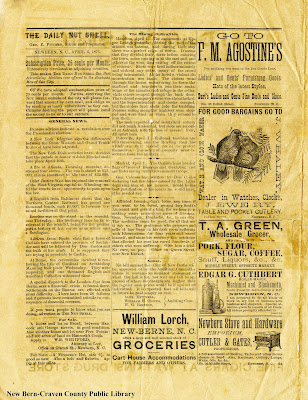or, how New Bern contributed to a national movement.
 |
| Front page, Little But Loud, New Bern, NC, October 1878. |
by John B. Green III
 |
| Advertisement for J.F. Dorman's printing presses, The Newbernian, 25 October 1879 |
While some youthful publishers made do with discarded bits of commercial equipment (Edison) and others cobbled together their own unique presses (the Wright brothers), the hobby blossomed once small, practical, "table-top" printing presses began to be patented and manufactured in the 1860s. Dozens of models became available and were widely advertised. J.F.W. Dorman of Baltimore, for example, advertised his presses in the The Newbernian on Oct. 25, 1879 with the double pitch of "Educate Your Boys by Giving Them a Printing Press!" and, targeting his other potential market, "Business Men, Do Your Own Printing. Economy is Wealth."
 |
| Page from catalog of J.F. Dorman Company, 1888. |
The least expensive presses sold for around a dollar, an amount that some of the boys were able to scrimp and save to accumulate. More expensive presses were financed by indulgent parents who no doubt saw such a hobby as a way to keep their boys out of trouble. But, lest you think all this was but a passing fad, there soon were hundreds of young printers across the country and a score or more teenage publishers in North Carolina. There were enough junior printers, in fact, to warrant the establishment of the North Carolina Amateur Press Association in 1877, with its semi-official trade journal, the North Carolina Amateur.
 |
| Masthead, North Carolina Amateur, Rose Hill, September 1879 |
Which brings us to the Little But Loud of New Bern and its young editors, Ham Disosway and T.C. Howard. Harry Hamilton Disosway and Thomas C. Howard were both about 18 years old when they founded the Little But Loud. Disosway was the son of New Bern druggist Israel Disosway, and Howard was the son of New Bern shipbuilder and mill owner Thomas S. Howard. Their reasons for starting the paper are unknown, as is the type of press they used, or how they acquired their equipment. Inspiration and assistance may have come from Howard's first cousin James M. Howard who had recently begun to publish his own amateur paper, the Boys' Courier. The Little But Loud was issued monthly, with a year's subscription available at 20 cents, paid in advance. The contents were chiefly humorous with no real news coverage. The issue shown here does contain one advertisement for C. Erdman's Emerald Cigar Factory, an actual New Bern business.
 |
| Little But Loud, page two. |
 |
| Little But Loud, page three |
Despite the brief run of their paper, both Ham Disosway and T.C. Howard were active in the amateur journalism community with Disosway serving as Treasurer and Howard as Sergeant at Arms of the North Carolina Amateur Press Association. In later years, Disosway would become a druggist like his father, and Howard would be involved in his father's various businesses. Like most of their fellow "amateurs," neither would chose printing or publishing as a career.
 |
| Little But Loud, page four. |









